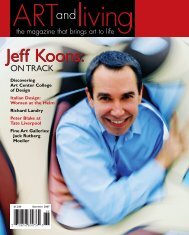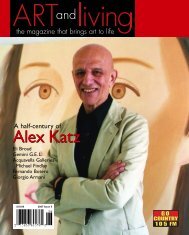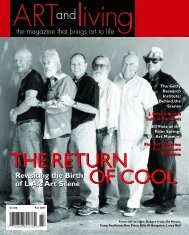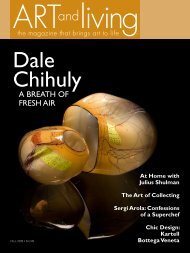Ed Ruscha Ed Ruscha Ed Ruscha - Art and Living
Ed Ruscha Ed Ruscha Ed Ruscha - Art and Living
Ed Ruscha Ed Ruscha Ed Ruscha - Art and Living
- No tags were found...
Create successful ePaper yourself
Turn your PDF publications into a flip-book with our unique Google optimized e-Paper software.
Martin Mull, Emotional Insurance, 2000. Watercolor on paper. Image courtesy the artist.Mull admits,“I just like the paint <strong>and</strong> acrylic just doesn’t do what oils do, it doesn’tfeel the same on the brush to me; I like the smell, I like the history.”Just as the retrospective enables Mull to reminisce amongst old “friends,” thepieces in turn quintessentially distill the essence of 1940s/1950s middle America.“It isn’t a societal commentary like ‘Boy, look what we’ve lost,’ or,‘Boy, look wherewe’re headed,’” Mull laughs. “It’s not that generous. It’s more about my ownchildhood <strong>and</strong> trying to underst<strong>and</strong> what it all meant. And if the viewer says ‘Mygod, we’ve lost it,’ ‘Those were the good old days,’ or even ‘Boy, we’ve come along way’ or any of that, then so be it. I’ve made an object, <strong>and</strong> hopefully it’s anobject that’s evocative.”Despite the inherent societal commentary of any art that reflects a timewhich is not the present, Mull indicates that, at the “inconceivable” age of 63, hiswork is self-exploratory,“just in terms of growing up, everything goes so fast <strong>and</strong>you don’t have much time to examine it, it’s just like ‘Whoa…what was that?’ <strong>and</strong>so, in a way, it’s trying to go back, <strong>and</strong> trying to examine some of the visual emotionsthat substantiated <strong>and</strong> described…my life.”That sense of self as his craft’s compass points seems to translate into a senseof his work’s utilitarian importance. “I believe in what Samuel Goldwyn said: thatmessages should be sent by Western Union. People come up <strong>and</strong> say ‘What doesit mean?’ but I ask myself the same question. I just work on things until the combination—ofthe structure of the piece, the tension between the images, thecolor—the whole thing will coalesce into something that takes me back, or seemsfamiliar, or seems like it hangs together. And then I stop.”With his work now held (among many other places) in the public collectionsof LACMA,The Metropolitan Museum of <strong>Art</strong>,The Whitney, the Orange CountyMuseum of <strong>Art</strong>, the Harvard Museum of Fine <strong>Art</strong>, as well as the private collectionsof Richard B. Sachs, Steve Martin, New York’s David Beitzel, <strong>and</strong> BergamotStation’s own Patricia Faure, it’s fair to say that Mull’s work achieves more thanthat seemingly modest purpose of self-fulfillment.Maintaining a disciplined, 80-hour work schedule (with breaks for baseballcoverage when the afternoon light streaks across his studio), Mull works in thesolitary vacuum of his sizeable studio above the garage of the Brentwood home<strong>Art</strong> <strong>and</strong> <strong>Living</strong> 77






